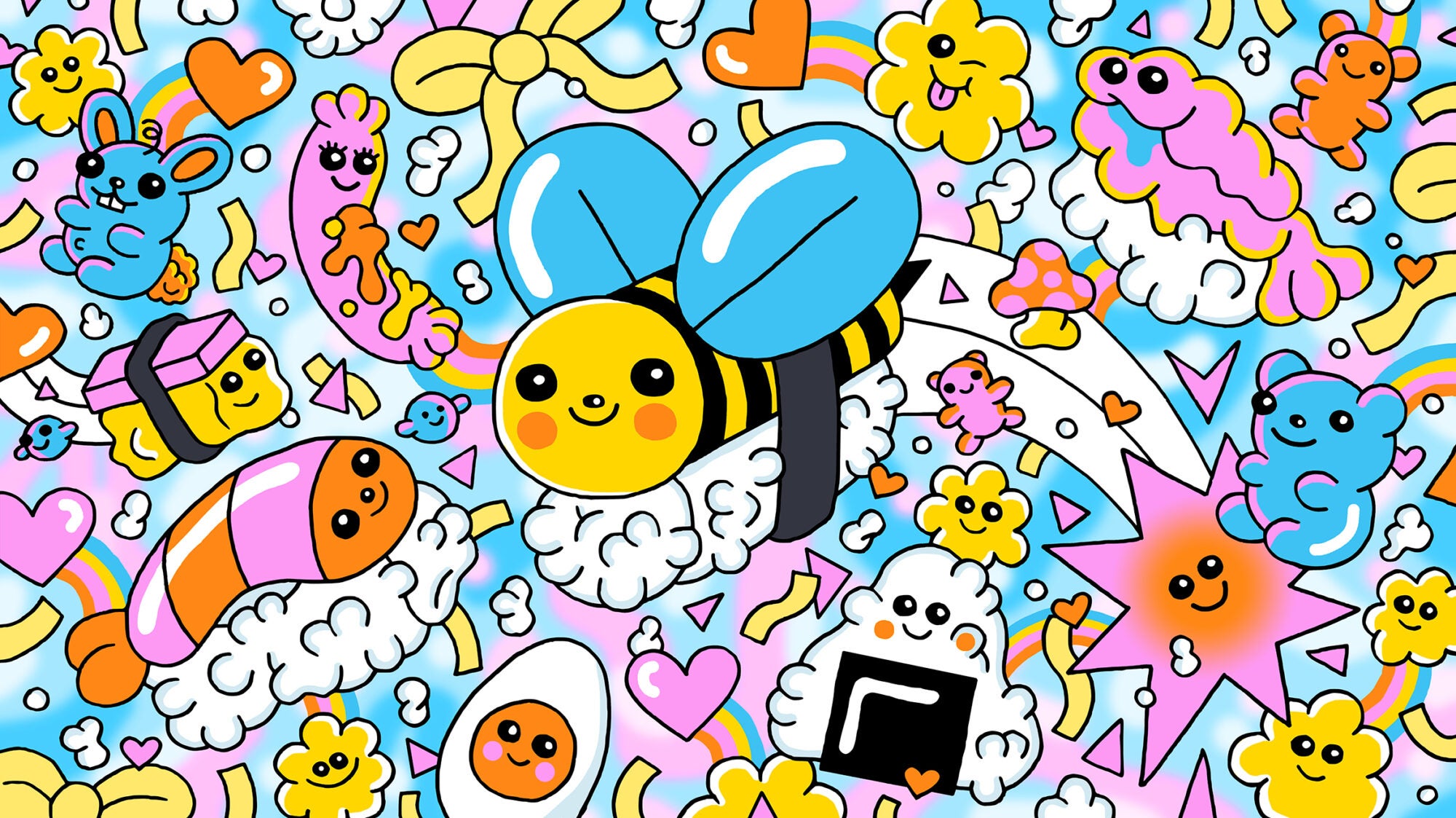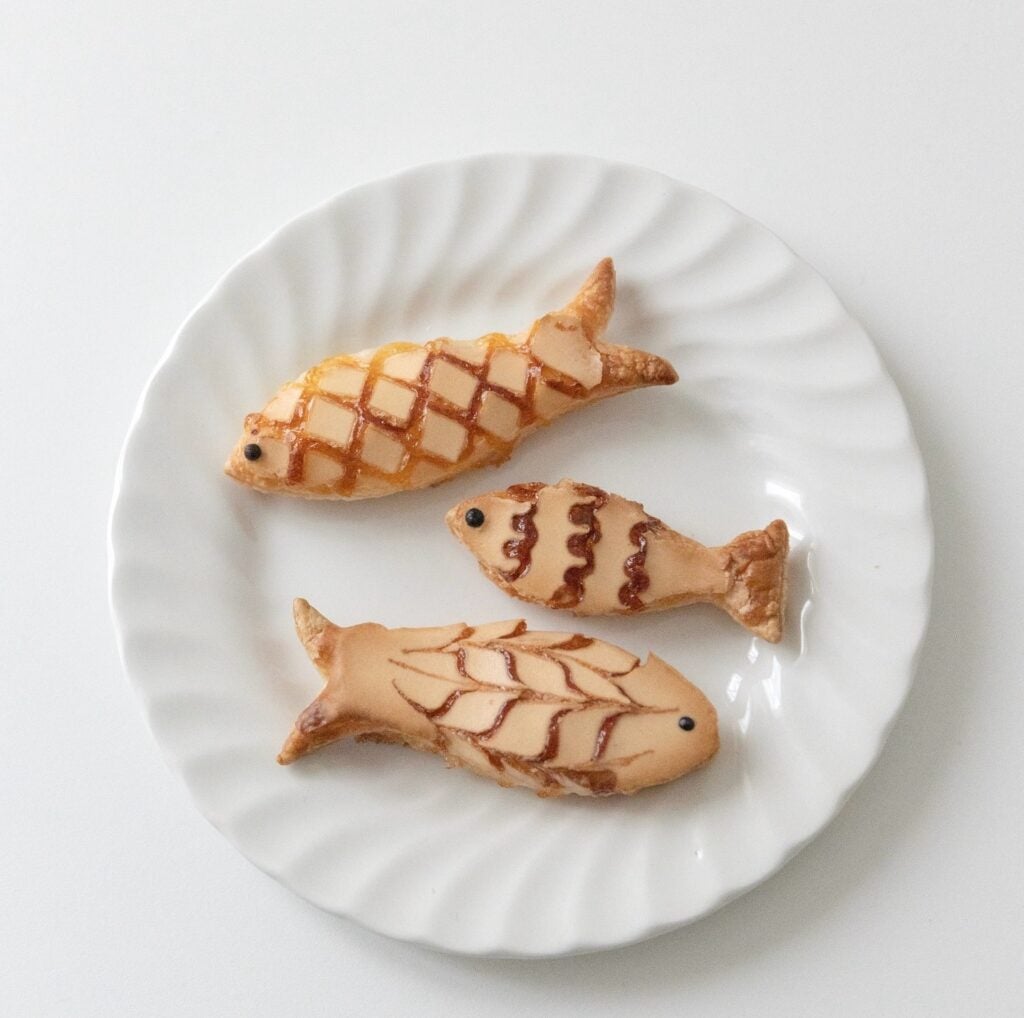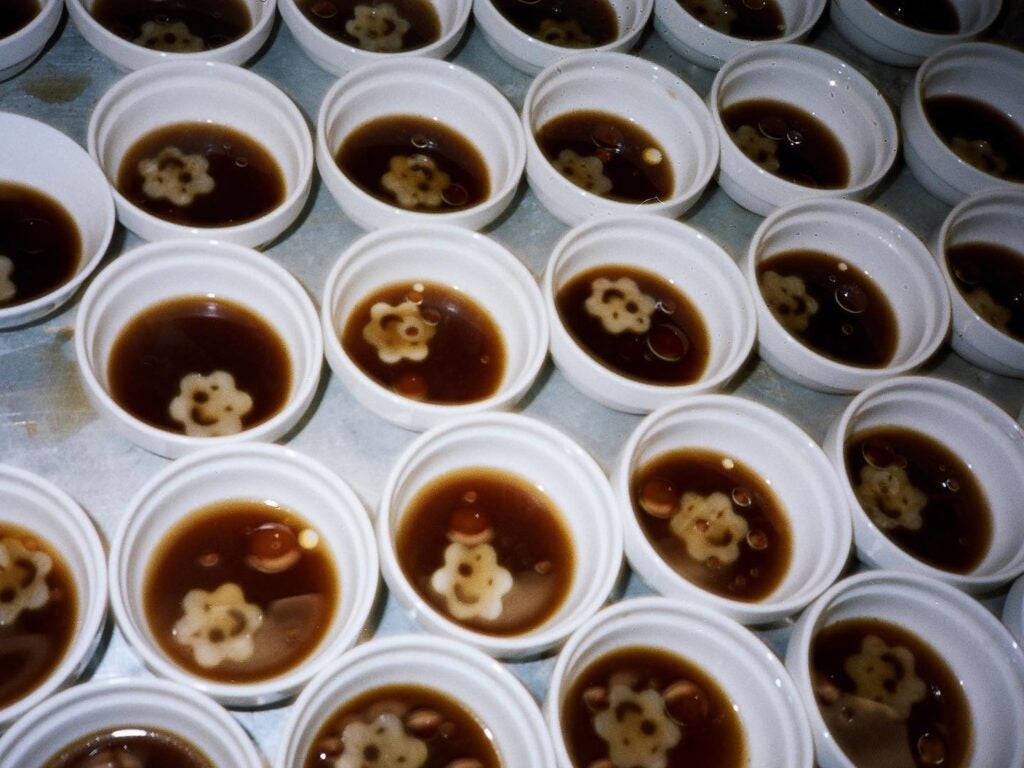
Chefs, creators, and recipe developers are leaning into the giddy-inducing aesthetic, from bee-shaped tamago sushi to soup that smiles back.
Je Wallerstein didn’t want to do just any beet salad at Fabrik, her plant-based tasting menu restaurant in Austin, Texas. “Especially at a vegan restaurant, you don’t want to give people a salad, you know?” she explains. Instead, she thinly cut golden beets into mandarin-orange-size circles, filled them with beet cream and caramelized red onions, and folded them into half-moons. She arranged the dumpling-like parcels on top of a smoked almond ricotta with quartered segments of marinated baby red beets, ombre beet greens, petals of sliced pear, and micro marigold flowers. Looking over the dish, Wallerstein thought to herself, “This is cute.”
“Cute” isn’t something you usually hear in serious restaurant kitchens. In fact, “cute” isn’t really used to describe savory food at all; it’s typically reserved for buttercreamed cupcakes and sugar cookies cut out in the shape of kittens. It’s a term that’s synonymous with happy afternoon baking, not long-simmered braises. Both the “avant-garde” of genius chefs in tweezer-powered kitchens and the “easy” pragmatism of everyday recipes in food publications and on TikTok feeds are forms of cooking that demand a different slew of adjectives—usually ones that get at their impact, whether visionary or practical. Food that is cute offers something else, and lately, I’ve been seeing more of it in restaurants, both fancy and casual, and as pleasing punctuations in my endless Instagram scroll.
“When you can see something as cute, you’re striking a different chord,” Wallerstein says. “It elicits more of an emotional response. You want to grab it, you want to embrace it.”
These days, chefs like Wallerstein, along with other like-minded recipe developers and creators, are harnessing the power of cuteness, sometimes intentionally, other times accidentally. In turn, they are challenging—and even changing—the way we consume, enjoy, and value savory food.
But first, what even is cute food? As I began my deep dive, I jotted down these descriptors: tiny, plump, squishy, furry but not hairy, swirled/patterned, harmless, happy, replicating nature or something man-made that is already deemed cute. The words varied from pure aesthetic to hard-selling value. I see these characteristics in foods that are naturally cute, like juicy Sungold cherry tomatoes from the farmers’ market, as well as in foods that are man-made but not necessarily produced for cuteness, such as perfectly round bao. I see it in foods from the past that are aesthetically driven, like the diminutive tea sandwiches of British high society and intricately plated food from Chinese chefs in the ’80s and ’90s, as documented by librarian Dieter Mackenbach.
They’re springboards for what’s happening now with cute aesthetic in food, from creator Celine Rousseau’s edible versions of cute things (grissini bows, bee-shaped tamago sushi) to chef Jeremy Salamon’s abstract leanings at the Brooklyn restaurant Agi’s Counter (egg mousse squiggled onto toast, little torpedoes of lamb-stuffed cabbage). To me, they’re not just satisfying to look at but absolutely delicious, and I’m not the only one fascinated by this: Cuteness in food has been a fixture in academia (see the defining Our Aesthetic Categories: Zany, Cute, Interesting by Sianne Ngai, an English professor at the University of Chicago).

Celine Rousseau’s edible versions of cute things has taken off online.
“Cuteness is an aesthetic category, one that often resists definition because it’s so tied up in associations with things that inspire fondness and because of their associations with childhood, smallness, softness, and other kinds of tender qualities or feelings,” says Erica Kanesaka, an assistant professor of English at Emory University and a writer and researcher specializing in the racial and sexual politics of kawaii and cuteness.
Many psychologists believe our initial draw to cuteness comes from evolution. In order to care for our helpless (and frankly annoying) offspring, we needed to find babies cute—their miniature stature, their big eyes, their wobbly cheeks and limbs. It was only a matter of time before cuteness expanded beyond its original purpose and became a visual standard, or, as Makenzie O’Neil, an assistant professor of psychology at Saint Mary’s College of California, puts it: “It basically extends to anything that fits the same prerequisites for cuteness. It’s like the system has been co-opted by all these other entities that now exist.” If something is small and chubby, it’s probably cute.
That is particularly true of sweets. Any oversize cupcake, perfect strawberry, or fondant-frosted anything is easily and unabashedly given the status of cute. These desserts check all the aesthetic hallmarks of my cuteness litmus test and tend to be made with colorful ingredients or dyes and sweet-specific elements that can be controlled (sugar, chocolate) to make them look even cuter. However, there is a certain frivolity to sweets—perhaps it’s because they’re seen as optional add-ons at a meal’s conclusion, or because of what extra cute ones can elicit: immediately whipping out our phones to take a photo, squeals of “It’s so cute!” (of which I am guilty), an urge to get closer. In desserts, we see both the strength and weakness of cuteness: it’s intimate in an almost embarrassing way, and that can be seen as unsophisticated or silly.
“If you were trying to communicate a very complex, highbrow flavor,” muses Oriana Aragón, an assistant professor of marketing at the University of Cincinnati, “you would not use cuteness, right?”
That may very well be the reason why cute savory food is becoming more of a thing. Nearly everyone I talked to noticed how cuteness has long been embraced by a particular set of demographic groups: women and girls, queer folks, and Asian cultures—marginalized people not typically seen at the helm of restaurants and the forefront of media. However, a new generation of folks in the kitchen and behind the camera tend to fall into these categories, and they’re channeling this aesthetic that they’ve always known. For some, it’s deliberate, but for many, it’s a coincidence, a reflection of visual cues they’ve absorbed, accepted, and made their own. “Cute finds its way into all sorts of flavor profiles,” observes Soleil Ho, a cultural critic and former restaurant critic at the San Francisco Chronicle.
“I just don’t think I’ve ever really thought of cuteness with our stuff,” shares Kevin Le of SeeYouSoon, a globe-circling, Toronto-based culinary collective from three friends. “It just ends up being cute because of our approach.”
“We’ve all been trained at very high levels, but we don’t take ourselves seriously,” Michael Ovejas, the second member of SeeYouSoon, adds. “We’re just three guys who like to cook, and we want to throw our personalities into that cooking, which is silly and cute sometimes.”
I jotted down these descriptors: tiny, plump, squishy, furry but not hairy, swirled/patterned, harmless, happy, replicating nature or something man-made that is already deemed cute.
The members of SeeYouSoon have fine-dining pedigrees, but they focus that energy on unfussy, wine-bar-adjacent food in chill spaces, an ideal setting for cute food. The guys behind SeeYouSoon remember one particular dinner, a collaboration with a supper club in Toronto that typically begins with a psychedelic microdose of mushrooms. Instead of serving the dose straight up, they turned it into a small sandwich shaped like a cartoon mushroom worthy of any Super Mario game, dusting it with tomato powder and Parmesan. Guests began swarming their prep station before they even sat down for dinner.
“It’s a cheeky joke that we share with them, not like a joke we play on anybody,” Keith Siu, SeeYouSoon’s third member, explains. “I think it makes people really comfortable. Without anybody saying anything to them, it sets the tone of how they should feel when it comes to our dinners.”
Like the SeeYouSoon crew, almost everyone I talked to hadn’t really considered whether the food they make is cute. They were all just cooking in a way that felt emblematic of their style. While this process comes naturally to them now, it wasn’t always that way.
“Going back ten, twelve years, when I was a line cook, it certainly would never have crossed my mind to say out loud to my superior, ‘Oh, wow, that dish is so cute’ or ‘so pretty,’ words that might actually be natural for me to say or think about a dish,” Salamon says. “It was never something spoken in an all-male—especially straight-male-dominated—kitchen. Those were words that were not used.”
To that point, he recalls how, years ago, one chef complimented his food at a restaurant he was working at by calling it “handsome.” (“I just remember thinking, ‘Oh, well, that’s a first,’” he says.) When Salamon, who is gay, decided to open Agi’s Counter, an Eastern-European-inspired restaurant in Crown Heights, he wanted to create a more inclusive space, not only in vocabulary but in atmosphere. If you happen to be back in the kitchen at the restaurant, you’ll often hear Salamon and his team throw around the word “cute”—“fabulous” sneaks in, too—as they’re plating a new dish.
“We’re liberated,” Wallerstein jokes. “Now we can use the word. You can say whatever you want.”

See You Soon’s maitake dashi smiles.
Where the word “cute,” as well as its cousin “adorable,” has also proliferated is in the comments of social media accounts for creators and recipe developers like Diana Yen (and in my own brain as the idea for this story came about). An almost physical joy took over as I looked at her tamago kake gohan adorned with salted cherry blossoms and her miniature lobster pot pies with tiny heart cutouts. These are recipes created not only for consumption but also for delight.
“Yes, it could be seen as an extra step with recipes, and other people may not make them, but they love to see them,” she says. “It’s just a way of playing as an adult in the kitchen. You keep your sense of wonderment and joy.”
This idea came up a lot in the conversations I had with chefs, creators, recipe developers, and psychologists: cute food brings us back to childhood nostalgia and, in turn, connects with us on a deeper, more personal level. SeeYouSoon’s maitake dashi smiles back at us as we look at the star-shaped daikon with punched-out faces floating on top, a nod to the pop-up’s logo. Rousseau blooms flowers on pasta sheets, while Yen rolls pasta dough into sweetly tied bows. Cute food pushes against the ideas and assumptions we’ve long held about savory stuff—that it needs to be serious or useful. Instead, it gives us permission to play.
One of the things Jen Monroe, a chef, artist, and food designer behind Bad Taste, is known for is her “cruditables”: long buffets covered in a rainbow of dips with “families” of sliced produce, quail eggs, and crackers nestled in.
“You have this huge landscape, which maybe evokes the natural world, maybe evokes the city, whatever speaks to you,” she says. “But then when you zoom in, you can kind of see these little micro compositions of tiny vegetables that play with that scale of macro and micro. For me, that’s adorable.”
Whenever Monroe guides those helping her to assemble these tablescapes, it triggers an oddly universal response: “Some people just lose their mind,” she says. “They’re like, ‘Oh my God, it’s like two parent cucumbers and their quail egg baby.’” But she lives for the moment when a diner finally plucks up a radish, runs it through the dips, and bites right into it.
“There is some kind of small kernel, a potentially violent impulse or something that’s a little bit off,” Monroe says. “There’s this kind of perverse joy that you can really destroy this thing that’s so adorable.”
A certain darkness exists within cuteness, and savory food that registers as cute seems to unlock it.
“It’s just a way of playing as an adult in the kitchen. You keep your sense of wonderment and joy.”
In a Yale study, Aragón identified and coined “cute aggression,” essentially the reason you might react to something so cute by wanting to squish, pinch, or nibble it. Though it’s thought that cuteness evolved out of a need to care for offspring, sometimes this reaction to a cute thing can be so overwhelming (have you seen breadlike baby arm rolls?!) that it can distract from caretaking, which could threaten the survival of said cute being. Cannibalism is one thing, but devouring a viral persimmon-shaped tangyuan and dissolving a hot pot soup base molded into a teddy bear is another.
“When you see something cute, you can easily devolve into saying, ‘Oh, you’re so cute, I just want to eat you up.’ So there’s something aggressive about the desire to regard the cute object,” Kanesaka explains. “Cuteness has this ambivalence where you’re feeling this fondness but at the same time enjoying your superiority or aggression over the object.”
Cute aggression allows the beholder or the caretaker to express their desire—through a quick squeeze of a chubby baby leg, smushing your face into a stuffed animal, an exclamation of “You’re so cute!”—and snap out of any cuteness-induced stupor, to go back to caring for the cute thing.
But what if you could actually act on the impulse to eat what you find cute? To me, this is the power of cute food. It gives permission: to make “serious” food that doesn’t take itself so seriously, to push against kitchen culture that upholds a myopic (often masculine) point of view, to challenge the formality and function of cooking and play more in the kitchen, to swallow whole the object of our desire. Cute savory food breaks down the distance between eaters and the food in front of them—its happy squish, its little curlicues and cutouts, its safe, cartoon-y versions of the world, and its irresistible tenderness invite us to surrender and bend toward our human proclivity to make a thing we love part of us.
“I joke that my permanent way of being when I go around in the world is asking, ‘Can I eat this?’” Monroe says. “And the thing that’s really exciting about cute food is that, yes, it’s adorable, and yes, that tiny little voice inside of you that is calling you to squish your face into it or crush it in your mouth or your hands—the answer to that is yes, yes, you can.”